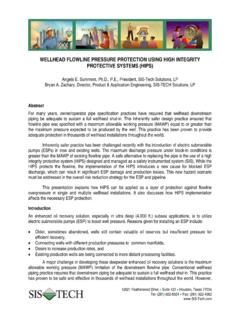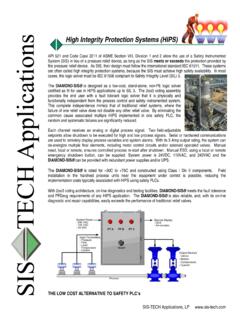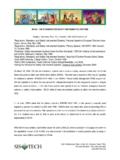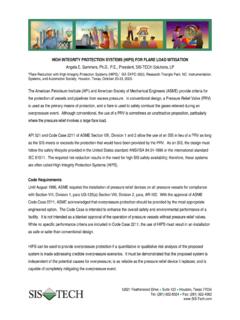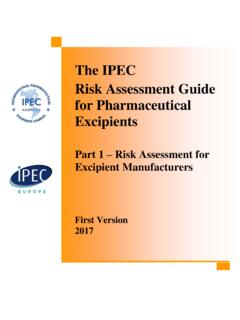Transcription of INTRODUCTION TO LAYER OF PROTECTION ANALYSIS
1 12621 Featherwood Drive Suite 120 Houston, Texas 77034 Tel: (281) 922-8324 Fax: (281) 922-4362 INTRODUCTION TO LAYER OF PROTECTION ANALYSIS Angela E. Summers, , , President, SIS-TECH Solutions, LP INTRODUCTION to Layers of PROTECTION ANALYSIS , Mary Kay O Conner Process Safety Center Symposium, Texas A&M University, College Station, Texas, October 2002. INTRODUCTION to Layers of PROTECTION ANALYSIS , Journal of Hazardous Materials, 104 (2003).
2 INTRODUCTION to Layers of PROTECTION ANALYSIS , Angela Summers and Scott Sandler, ISA EXPO 2003, Research Triangle Park, NC: Instrumentation, Systems, and Automation Society, Houston, Texas, October 20-23, 2003. Keywords Layers of PROTECTION ANALYSIS , LOPA, hazard ANALYSIS , PROTECTION layers, IEC 61511, ANSI/ISA , risk mitigation Abstract Layers of PROTECTION ANALYSIS (LOPA) is a powerful analytical tool for assessing the adequacy of PROTECTION layers used to mitigate process risk. LOPA builds upon well-known process hazards ANALYSIS techniques, applying semi-quantitative measures to the evaluation of the frequency of potential incidents and the probability of failure of the PROTECTION layers.
3 This paper will provide an overview of the LOPA process, highlighting the key considerations. INTRODUCTION The process industry is obligated to provide and maintain a safe, working environment for their employees. Safety is provided through inherently safe design and various safeguards, such as instrumented systems, procedures, and training. During a hazop , the team is responsible for assessing the process risk from various process deviations and determining the consequence of potential incidents. The team identifies the safeguards used to mitigate the hazardous event. If the team determines that the safeguards are inadequate, the team will make recommendations for further risk reduction.
4 The team is instructed to list all safeguards. The team often lists safeguards that only partially mitigate the process risk. The team also does not address whether the safeguards are independent from one another. This often results in the team assuming more risk reduction from the safeguards than is possible based on the integrity of the individual components. Furthermore, a team s perception of the integrity of a specific safeguard impacts the assumed risk reduction for that safeguard, resulting in inconsistency in the number of required safeguards for successful mitigation of the process risk. Unfortunately, the inconsistency can result in over- and under-protected process risk, depending on the team composition.
5 Consequently, there must be an independent engineering assessment of the safeguards to ensure that adequate risk reduction is being provided. June 15, 2007 Page 2 of 6 12621 Featherwood Drive, Suite 120 Houston, Texas 77034 What is LOPA? Layers of PROTECTION ANALYSIS (LOPA) is a semi-quantitative methodology that can be used to identify safeguards that meet the independent PROTECTION LAYER (IPL) criteria established by CCPS1 in 1993. While IPLs are extrinsic safety systems, they can be active or passive systems, as long as the following criteria are met: Specificity: The IPL is capable of detecting and preventing or mitigating the consequences of specified, potentially hazardous event(s), such as a runaway reaction, loss of containment, or an explosion.
6 Independence: An IPL is independent of all the other PROTECTION layers associated with the identified potentially hazardous event. Independence requires that the performance is not affected by the failure of another PROTECTION LAYER or by the conditions that caused another PROTECTION LAYER to fail. Most importantly, the PROTECTION LAYER is independent of the initiating cause. Dependability: The PROTECTION provided by the IPL reduces the identified risk by a known and specified amount. Auditability: The IPL is designed to permit regular periodic validation of the protective function. Examples of IPLs are as follows: Standard operating procedures, Basic process control systems, Alarms with defined operator response, Safety instrumented systems (SIS), Pressure relief devices, Blast walls and dikes, Fire and gas systems, and Deluge systems.
7 LOPA is not just another hazard assessment or risk assessment tool. It is an engineering tool used to ensure that process risk is successfully mitigated to an acceptable level. LOPA is a rational, defensible methodology that allows a rapid, cost effective means for identifying the IPLs that lower the frequency and/or the consequence of specific hazardous incidents. LOPA provides specific criteria and restrictions for the evaluation of IPLs, eliminating the subjectivity of qualitative methods at substantially less cost than fully quantitative techniques (1). When is LOPA Used? LOPA can be used at any point in the lifecycle of a project or process, but it is most cost effective when implemented during front-end loading when process flow diagrams are complete and the P&IDs are under 1 CCPS/AIChE, Guidelines for Safe Automation of Chemical Processes, 1993, pp.
8 7-16. June 15, 2007 Page 3 of 6 12621 Featherwood Drive, Suite 120 Houston, Texas 77034 development. For existing processes, LOPA should be used during or after the hazop review or revalidation. LOPA is typically applied after a qualitative hazards ANALYSIS has been completed, which provides the LOPA team with a listing of hazard scenarios with associated consequence description and potential safeguards for consideration. A LOPA program is most successful when a procedure is developed that sets the criteria for when LOPA is used and who is qualified to use it. A well-written procedure will also incorporate criteria for evaluation of initiating cause frequency and IPL probability to fail on demand (PFD).
9 The development of these criteria takes time, but this cost is rapidly offset by the increased speed at which LOPA can be implemented on specific projects. What is the LOPA process? The overall LOPA process is illustrated in Figure 1. Depending on the project stage, the process may be initiated differently from what is represented. This should be considered a general overview of LOPA and not a limitation on its applicability. The six major steps to the LOPA process are as follows: 1) Record all reference documentation, including hazards ANALYSIS documentation, pressure relief valve design and inspection reports, PROTECTION LAYER design documents, etc. 2) Document the process deviation and hazard scenario under consideration by the team.
10 It is important to focus the team on a specific hazard scenario, such as high pressure resulting in pipeline rupture. 3) Identify all of the initiating causes for the process deviation and determine the frequency of each initiating cause. The team should list all initiating causes of the hazard scenario, such as loss of flow control, loss of pressure control, excess reaction, etc. The initiating cause frequencies should be based on industry-accepted and standards-compliant failure rate data for each device, system, or human. For rapid execution of the LOPA methodology, the initiating cause frequency for common systems should be provided in the procedure.
